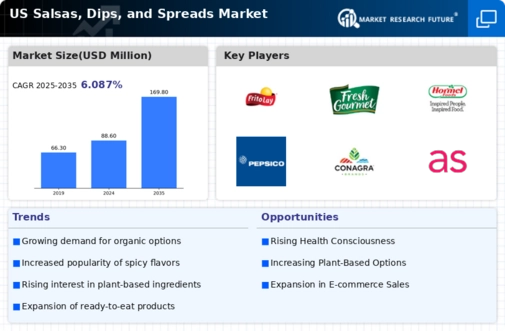Increased Snacking Culture
The salsas dips-spreads market is significantly impacted by the evolving snacking culture in the US. As lifestyles become busier, consumers are increasingly opting for convenient snack options that require minimal preparation. This trend is evidenced by a 20% increase in snack food sales over the past five years. Salsas and dips are often chosen for their versatility, serving as accompaniments to various snacks such as chips, crackers, and vegetables. The rise of social gatherings and informal dining experiences further fuels this demand, as consumers seek flavorful and shareable options. Consequently, manufacturers are innovating their product lines to include a variety of flavors and textures, catering to the diverse preferences of consumers. This shift towards snacking is likely to continue driving growth in the salsas dips-spreads market.
Expansion of Retail Channels
The salsas dips-spreads market is benefiting from the expansion of retail channels, which enhances product accessibility for consumers. The rise of e-commerce and specialty grocery stores has transformed the way consumers shop for food products. Data shows that online grocery sales have increased by 30% in the past year, indicating a shift in purchasing behavior. This trend allows consumers to explore a wider variety of salsas and dips, including niche and artisanal brands that may not be available in traditional supermarkets. Additionally, the presence of these products in convenience stores and food service establishments further broadens their reach. As retail channels continue to diversify, the salsas dips-spreads market is likely to experience sustained growth, driven by increased consumer exposure and availability.
Focus on Clean Label Products
The salsas dips-spreads market is increasingly influenced by the clean label movement, where consumers demand transparency regarding ingredients and sourcing. This trend is driven by a growing awareness of health and wellness, prompting consumers to scrutinize product labels for artificial additives and preservatives. Recent surveys indicate that 60% of consumers prefer products with simple, recognizable ingredients. In response, manufacturers are reformulating their salsas and dips to meet these expectations, often highlighting natural and organic components. This shift not only aligns with consumer preferences but also enhances the marketability of products in a competitive landscape. As the clean label trend continues to gain traction, it is likely to shape the future offerings within the salsas dips-spreads market.
Growing Interest in Ethnic Flavors
The salsas dips-spreads market is witnessing a surge in interest for ethnic flavors, reflecting the diverse culinary landscape of the US. Consumers are increasingly adventurous in their food choices, seeking authentic and bold flavors from various cultures. This trend is supported by data indicating that ethnic food sales have grown by 25% in the last three years. As a result, manufacturers are expanding their product offerings to include a wider range of salsas and dips inspired by global cuisines, such as Mexican, Mediterranean, and Asian flavors. This diversification not only enhances the appeal of the salsas dips-spreads market but also encourages consumers to experiment with new taste experiences. The incorporation of unique ingredients and traditional recipes may further strengthen brand loyalty and consumer engagement.
Rising Demand for Plant-Based Products
The salsas dips-spreads market experiences a notable increase in demand for plant-based products. As consumers become more health-conscious, they seek alternatives that align with their dietary preferences. This trend is reflected in the growing popularity of vegan and vegetarian options, which are often perceived as healthier. According to recent data, the plant-based food market in the US is projected to reach $74 billion by 2027, indicating a substantial shift in consumer behavior. This shift is likely to influence the salsas dips-spreads market, as manufacturers adapt their offerings to include plant-based ingredients. The incorporation of legumes, nuts, and vegetables into dips and spreads not only caters to this demand but also enhances the nutritional profile of these products, thereby appealing to a broader audience.



















Leave a Comment